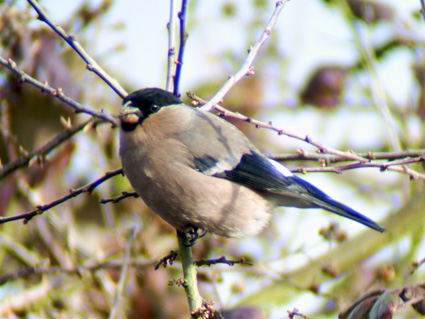Praktica digiscoping outfit 4: 77 mm telescope, zoom lens, 12 MP camera and digiscoping adapter
Praktica’s launch of four new digiscoping packages, comprising telescope, compact digital camera and digiscoping adapter, for the astonishingly low price of ‘around £200’ is sure to catapult the latest generation of new birders straight into digiscoping. That’s right, parting with what in today’s optics market is a ridiculously small sum of money can provide you with a nitrogen-filled, 77 mm telescope, complete with 20-60x zoom eyepiece, 12 MP HD digital camera and a digiscoping adapter, which is also compatible with some eyepieces and cameras from other manufacturers.
The scope is a distillation of value engineering. Its sleek, contemporary, carbon fibre-reinforced polymer body, thinly wrapped in rubber armouring, renders it incredibly light in weight; at a mere 1,070 g it is, for its size, one of the lightest scopes on the market. There is a pull-out rubber-covered lens hood and a 360° rotatable body ring, incorporating a rubber-soled tripod foot, which helps to increase grip when attached to the tripod head.
Both the single, broad focusing wheel and the integrated zoom eyepiece turn freely and smoothly and are easily operated with gloved fingers. There is a soft rubber eyecup that is comfortable against the eye, but which is too shallow to fold down, so the eye position cannot be varied. Protection for the objective lens is provided by a loosely fitting clip-in plastic cap, which did become detached while in the car.
The image is generally quite bright, even at 60x magnification. It also passes the ‘gull-roost test’ of performing well at low-light intensity, albeit on a restricted magnification range of 20-40x. Beyond this, the brightness takes a noticeable downward slide. I was pleasantly surprised by the image’s sharpness, which remained consistent almost to the edge of the field, with just a very narrow band of peripheral softness, where distortion resulting from curvature of field is practically negligible. This, however, is largely a function of the rather compact field of view: 29.3 m at 1,000 m at 20x magnification hardly pushes the wide-angle envelope, but it is in line with other scopes in the low-price category.
The colours, though very close to natural, are a shade darker than reality, and a yellowish cast has the effect of slightly subduing the colours, which themselves would benefit from a slight lift in contrast. However, even the obvious chromatic aberration, along with these minor gripes, can be tolerated when you look at what you are getting for your money!
To support the set-up I used a Giottos MTL 8261B carbon fibre tripod with VH6011-658D counterbalanced video/birding head. The universal digiscoping adapter is quickly and easily positioned over the eyepiece and clamped in place by tightening a plastic-headed bolt. The camera is then mounted on the adapter’s sliding plate and its position adjusted until it is in line with the eyepiece lens. The only disadvantage with this type of adapter is that you cannot use the zoom to vary the magnification when the adapter is attached. It is unlikely, however, that you would wish to increase the scope’s magnification beyond 20x, not only because it becomes more difficult to locate the subject, but also because the scope’s light-gathering capacity is best at its lowest magnification.
In most instances I chose to find the bird with the scope before fitting the adapter, as I found this quicker and easier than applying the adapter before attempting to find the bird on the camera’s large, three-inch screen, the latter method having limited degrees of success.
As compact cameras go, this is a fairly standard piece of equipment in terms of user friendliness. It does shoot video, but I concentrated on stills, the best of which, my chance local find of a first-winter female ‘Northern’ Bullfinch, is reproduced here.
 |
The digiscoping kit (right) produced acceptable record shots of this first-winter female ‘Northern’ Bullfinch. Photo by Mike Alibone. |
Images are written to the memory card in JPEG format, and the average file size is approximately 2.5 MB on the ‘Fine’ setting. There is no aperture-priority setting on the camera, so using this to maximise shutter speed to reduce image blur was not an option. I quickly found that the best results were obtained on ISO 400 and, as I shot only on sunny days, I tried to keep the brightness setting on zero. This was not always the case, however, and the ‘Northern’ Bullfinch was hurriedly shot on Auto-ISO at +0.5 on the brightness scale. To reduce blurring from image shake I used, where possible, the two-second self-timer, which produced the best results. I also experimented with a clip-on remote shutter release, but the Velcro attachment was not tight enough to consistently maintain positive contact with the shutter button.
I did not use macro mode, although some digiscopers swear by it. I left size, quality, sharpness and effect on the default settings, while I used spot metering to improve the exposure.
Generally, I found obtaining a sharp screen image could take many turns of the scope’s focusing wheel, and it is not overly sensitive. While this may suit some users, I often found it difficult to establish if the focus was optimised when looking at the camera’s screen.
Ultimately, however, it is possible to obtain very acceptable images, although light conditions will have significant influence on the amount of chromatic aberration reflected in the image.
Tech spec |
| Price: £249.99 Scope: Praktica 20-60x77 Camera: Praktica LM 12-HD |


